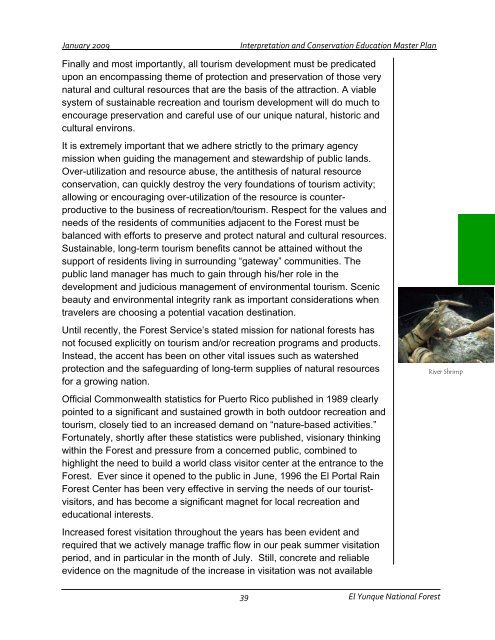2009 - USDA Forest Service
2009 - USDA Forest Service
2009 - USDA Forest Service
You also want an ePaper? Increase the reach of your titles
YUMPU automatically turns print PDFs into web optimized ePapers that Google loves.
January <strong>2009</strong> Interpretation and Conservation Education Master Plan<br />
Finally and most importantly, all tourism development must be predicated<br />
upon an encompassing theme of protection and preservation of those very<br />
natural and cultural resources that are the basis of the attraction. A viable<br />
system of sustainable recreation and tourism development will do much to<br />
encourage preservation and careful use of our unique natural, historic and<br />
cultural environs.<br />
It is extremely important that we adhere strictly to the primary agency<br />
mission when guiding the management and stewardship of public lands.<br />
Over-utilization and resource abuse, the antithesis of natural resource<br />
conservation, can quickly destroy the very foundations of tourism activity;<br />
allowing or encouraging over-utilization of the resource is counterproductive<br />
to the business of recreation/tourism. Respect for the values and<br />
needs of the residents of communities adjacent to the <strong>Forest</strong> must be<br />
balanced with efforts to preserve and protect natural and cultural resources.<br />
Sustainable, long-term tourism benefits cannot be attained without the<br />
support of residents living in surrounding “gateway” communities. The<br />
public land manager has much to gain through his/her role in the<br />
development and judicious management of environmental tourism. Scenic<br />
beauty and environmental integrity rank as important considerations when<br />
travelers are choosing a potential vacation destination.<br />
Until recently, the <strong>Forest</strong> <strong>Service</strong>’s stated mission for national forests has<br />
not focused explicitly on tourism and/or recreation programs and products.<br />
Instead, the accent has been on other vital issues such as watershed<br />
protection and the safeguarding of long-term supplies of natural resources<br />
for a growing nation.<br />
Official Commonwealth statistics for Puerto Rico published in 1989 clearly<br />
pointed to a significant and sustained growth in both outdoor recreation and<br />
tourism, closely tied to an increased demand on “nature-based activities.”<br />
Fortunately, shortly after these statistics were published, visionary thinking<br />
within the <strong>Forest</strong> and pressure from a concerned public, combined to<br />
highlight the need to build a world class visitor center at the entrance to the<br />
<strong>Forest</strong>. Ever since it opened to the public in June, 1996 the El Portal Rain<br />
<strong>Forest</strong> Center has been very effective in serving the needs of our touristvisitors,<br />
and has become a significant magnet for local recreation and<br />
educational interests.<br />
Increased forest visitation throughout the years has been evident and<br />
required that we actively manage traffic flow in our peak summer visitation<br />
period, and in particular in the month of July. Still, concrete and reliable<br />
evidence on the magnitude of the increase in visitation was not available<br />
39 El Yunque National <strong>Forest</strong><br />
River Shrimp

















